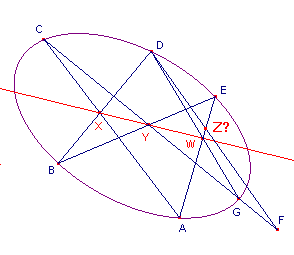Pascal's Theorem
Suppose that no three of the points A,B,C,D,E, are collinear.
If the point F lies on the conic determined by A,B,C,D and E,
then X = ACnDB, Y = CFnBE, Z = FDnEA are collinear.
The Converse
Suppose that no three of the points A,B,C,D,E, are collinear.
If X = ACnDB, Y = CFnBE, Z = FDnEA are collinear,
then the point F lies on the conic determined by A,B,C,D and E.
Proof of the Converse
Let C be the conic through A,B,C,D,E.

so that XY meets EA in Z.
The diagram is a little puzzling. It purports to show a case with F not on C.
But then the diagram indicates that X,Y and Z cannot be collinear, as X,Y,W are.
As the proof shows, the only way to resolve this is to have W = Z, so that F = G.